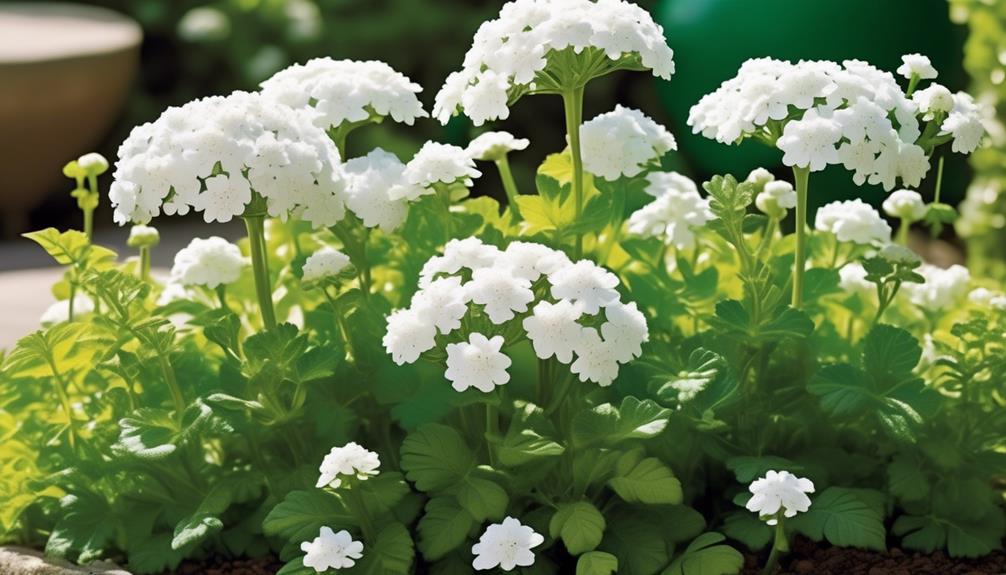Step into the world of nature's sweet cluster, where the tidy charm of candytuft awaits.
Amidst the chaos and unpredictability of the natural world, candytuft stands as a beacon of order and beauty. Its delicate blooms, in shades of white, pink, and purple, exude a sense of elegance and serenity.
But there is more to this enchanting plant than meets the eye.
So, come, let us explore the secrets of candytuft and discover the wonders it holds.
Plant Characteristics and Growth Requirements
Candytuft is a versatile and low-maintenance plant that thrives in various gardening conditions. These plants produce beautiful clusters of flowers that bloom in early to late spring, adding vibrant colors to your garden.
Candytuft plants can grow up to 12 inches tall and spread around 18 inches wide. Their foliage is green and adds a touch of elegance to any landscape. When planting candytuft, make sure to space them about 6 to 8 inches apart to allow for proper growth.
These plants require well-drained soil and prefer full sun, although they can tolerate some shade in hotter zones. With their hardiness and adaptability, candytuft is an excellent choice for any gardener looking for a low-maintenance and visually appealing addition to their garden.
Story and Origins
The origins of this captivating plant can be traced back to southern Europe and Northwest Africa, where it flourishes as a low-growing, spreading, evergreen ground cover. Candytuft, also known as Iberis sempervirens, is an excellent choice for gardens due to its versatility and beauty.
It produces clusters of candytuft flowers in an array of colors, including white, pink, and purple, adding a vibrant touch to any landscape. These flowers bloom in late spring and early summer, attracting pollinators and creating a delightful display.
To grow candytuft plants, sow Candytuft seeds indoors before the last expected frost or directly outdoors after frost danger. Ensure they receive full sun and well-drained, gravelly soil for optimal growth.
With its rich history and stunning appearance, candytuft is a charming addition to any garden.
Cultural Significance
With its deep roots in southern Europe and Northwest Africa, candytuft holds a rich cultural significance in gardening traditions across different regions.
This versatile plant, native to southern Europe, is commonly grown from softwood cuttings in the spring or early summer. Its dark green foliage and white flowers add a touch of elegance to any garden.
To grow Candytuft, plant the cuttings about an inch deep in well-drained soil, several weeks before the last frost. Candytuft can be both an annual and perennial, with popular varieties including the woody subshrub.
Its cultural significance extends beyond its beauty, as it attracts pollinators like bees and butterflies, symbolizing ecological balance and natural beauty. In gardens, candytuft bloom represents the arrival of spring and adds a touch of charm to the landscape.
Flower Color Symbolism
As we explore the significance of flower color symbolism, we uncover the hidden meanings and emotions conveyed through the language of flowers. Different flower colors carry specific meanings. For example, white symbolizes purity and innocence, pink represents admiration and gratitude, and purple signifies royalty and admiration.
Understanding flower color symbolism can enhance the sentiment and message behind floral arrangements and garden designs.
When it comes to the Candytuft, its delicate blooms appear in early spring and continue to bloom profusely for several weeks into late spring. With a growth habit of about 12-18 inches in height, Candytuft is hardy in USDA zones 3-9 and is considered hardy by many gardeners.
This selection of Candytuft is known to withstand slightly dry conditions and is resistant to fungal leaf spots.
Candytuft Watering Schedule
To ensure the healthy growth of your Candytuft, it's important to establish a proper watering schedule.
In late spring to early summer, when the plant is in its growing season, water it regularly. This is especially crucial for young plants that are still establishing their root system.
Candytuft prefers well-drained soil, so make sure to water moderately and allow the soil to dry out between watering. Overwatering can lead to root rot, so it's important to avoid this.
It's also advisable to water your candytuft in the morning, as this allows the foliage to dry throughout the day, reducing the risk of disease.
If you live in an area with a danger of frost, it's recommended to cut back on watering during this time.
Additionally, if you have your candytuft planted in a pot, make sure to use potting soil and provide it with a sheltered location in partial shade.
Best Occasions to Gift Candytuft
Candytuft makes for a perfect gift on special occasions such as spring birthdays, anniversaries, or to congratulate someone on a new home or job. Its delicate and vibrant flowers bloom in early to late spring, adding a touch of beauty to any landscape. Whether your loved one is an avid gardener or simply enjoys nature's wonders, candytuft is a thoughtful choice.
With its white or pink blossoms, named cultivars, and clusters of small flowers, this landscape plant is sure to impress. Candytuft thrives in well-drained soils and is ideal for rock gardens.
Concluding Thought
Now that you have learned about the best occasions to gift candytuft, let's wrap up our discussion with a concluding thought. Candytuft, with its vibrant colors and versatile nature, is a delightful addition to any garden or landscape. To ensure its optimal growth and health, there are a few key factors to keep in mind. Firstly, make sure to plant candytuft in well-drained soil, as poorly drained soil can cause yellowing and wilting. Additionally, providing direct sunlight will promote vigorous new growth and vibrant blooms. Regular pruning after the initial bloom will encourage bushier growth and extend the flowering period. To keep diseases like gray mold and powdery mildew at bay, it is recommended to apply a slow-release fertilizer. By following these guidelines, you can enjoy the full beauty of candytuft in your garden.
| Key Factors | Tips for Best Results |
|---|---|
| Soil | Well-drained |
| Sunlight | Direct sunlight |
| Pruning | After initial bloom |
| Fertilizer | Slow-release |
| Disease Control | Regular monitoring |
Frequently Asked Questions
How Do You Keep Candytuft Blooming All Summer?
To keep candytuft blooming all summer, give it full sun and well-drained soil. Deadhead the flowers, water regularly, and use a slow-release fertilizer with low nitrogen and high phosphorous. Pruning after initial bloom promotes bushier growth and more flowers.
Where Is the Best Place to Plant Candytuft?
The best place to plant candytuft is in a sunny spot with well-drained soil. Avoid overwatering and choose a location with lower humidity levels for optimal blooming. Consider your specific climate and zone requirements for successful planting.
Does Candytuft Come Back Every Year?
Yes, candytuft comes back every year, like a faithful friend. With proper care, perennial varieties will bloom year after year, while annual varieties can be replanted from seeds for consistent blooms.
Does Candytuft Like Sun or Shade?
Candytuft likes sun but can handle some shade in hotter areas. It thrives in well-drained soil and needs less watering as it grows. It prefers drier, less humid conditions.





